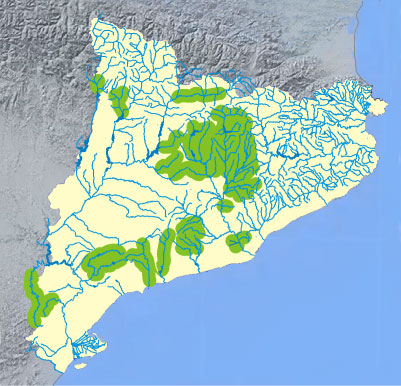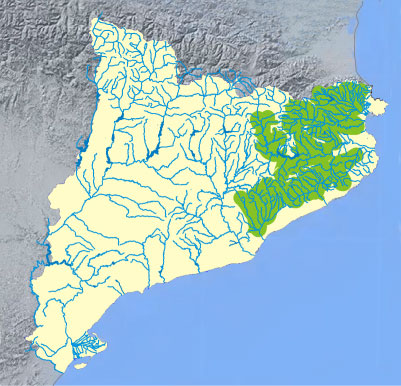Red-tail barbel
Barbus haasi

The maximum size they can reach is about 28 cm, the males being smaller than the females. The lips are thick and next to the mouth have two pairs of barbels. The coloration is brown, with small dark spots on the body and fins. The caudal and anal fins usually have reddish colorations
It is an endemic species of the northeast of the Iberian Peninsula that is distributed between the basins of the Llobregat and the Turia. It lives mainly in small mountain rivers, but it is also found in the middle and lower parts of rivers if they have stony substrates. They breed in spring and early summer. It feeds on all kinds of benthic invertebrates.
The red-tailed barbel has disappeared from some rivers due to various impacts such as pollution, flow regulation and water extraction, but it is still abundant in rivers that maintain good environmental conditions.
Distribution

Mountain barbel
Barbus meridionalis

The mountain barbel reaches a maximum size of about 25 cm. The head is relatively large, with a mouth bordered by two pairs of barbels. The coloration is brownish-yellow, with small dark spots on the body and fins.
The mountain barbel is endemic to the Mediterranean basins that flow into the Gulf of Leon. In Catalonia we find it from the river Besòs to the north, and its distribution extends to northern Catalonia and southern France.
Its preferred habitat is small and medium-sized rivers, of running water and bottoms of rocks and stones. They breed in spring and early summer. The diet is based primarily on benthic invertebrates.
It is sensitive to habitat alterations, water extraction and the introduction of exotic species. It has suffered a moderate regression, but it still has a wide distribution and can be locally abundant.
Distribution

Ebre barbel
Luciobarbus graellsii

It is a large fish, which can reach a size of up to 80 cm. He has very thick lips from which two pairs of barbels come out. The coloration is brown with golden reflections.
It is an endemic species of the Ebro basin. In Catalonia, in addition to the Ebro basin, has been introduced into the basins of Francolí, Llobregat, Besòs, Ter, Muga and Fluvià.
It lives in the middle and lower reaches of rivers, and can also be found in reservoirs. It breeds in spring and early summer. It feeds on invertebrates and algae.
It has suffered a certain regression in the Ebro basin due to the degradation of the habitat, hydrological alterations and the presence of exotic species.
Distribution

